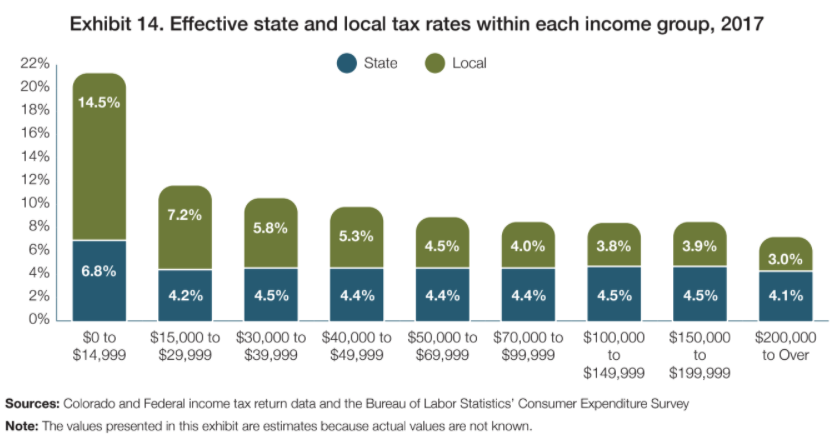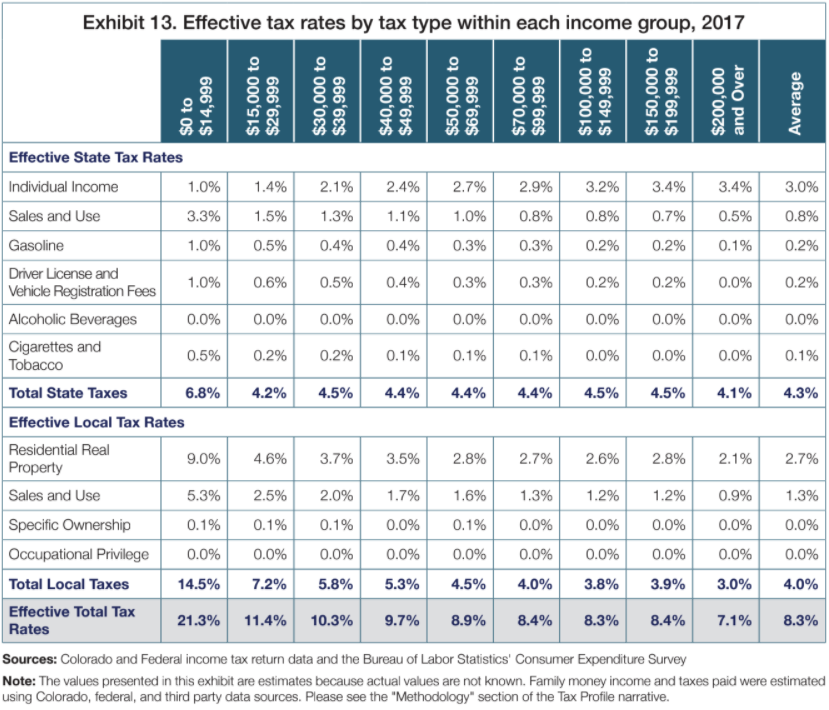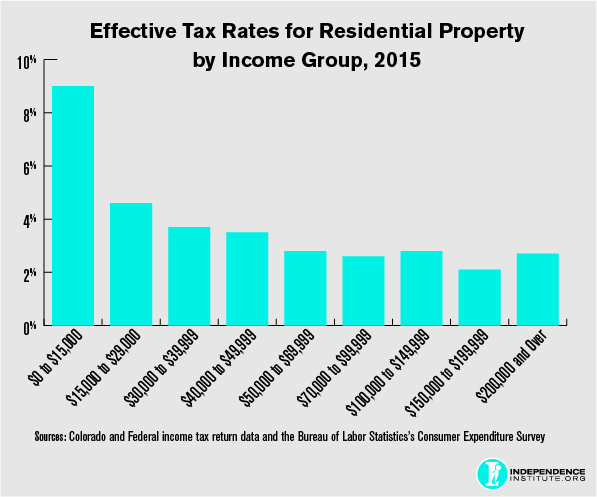Colorado has a regressive tax burden that punishes the poor. It’s not fair.
Voters in the Centennial State heard that a lot last year, but is it true? If so, how and why, and what should be done about it?
Key Takeaways:
- The Colorado tax code imposes an overall regressive tax burden.
- While the overall tax burden is regressive, the state’s flat rate income tax is effectively progressive. Every other state and local tax is effectively regressive.
- To equalize the effective total tax burden across income levels, policymakers could either lower rates for the current regressive taxes, or they could make the income tax even more progressive.
- The debate over tax fairness is not really about tax fairness. It’s about the proper role, size, and scope of the state government.
- Fiscal conservatives welcome the opportunity to make the tax burden more equal across income levels by lowering taxes on the poor. Progressives reject this option, because it would decrease government revenues.
- Colorado Progressives perpetually propose and pass tax changes that increase taxes on the poor and make our tax code more regressive. This suggests that Progressives care most about growing government revenues, even at the cost of increasing inequities in the tax code.
- The answer to a regressive tax code is less taxes, not more. This solution would also increase individual freedom and create opportunity for people at all income levels.
Is Colorado’s Tax Code Regressive?
The overall tax burden at the state level is generally regressive, meaning that as a percentage of income, lower earners pay more in taxes than higher earners. The graph below, published in the annual Tax Profile & Expenditure Report by the Colorado Department of Revenue, demonstrates that point:

Those making under $15,000 per year pay 21% of their income in state and local taxes while those making over $200,000 pay only 7%, on average. To understand why, we have to break down the numbers:

The first row in the data table above, “Individual Income” tax, reveals that Colorado’s flat income tax is effectively progressive; proportionate to their income, higher earners pay more than lower earners. This is because lower earners generally have more tax credits and deductions that reduce their taxable income compared with higher earners. They apply the same flat tax rate to a smaller portion of their income, reducing their effective income tax rate. If you put the first row of the chart into a graph, it looks like this:

Colorado’s overall tax burden disproportionally hurts the poor not because of the income tax, which is progressive, but because every other state and local tax is regressive. The other taxes place such an unbalanced burden on lower earners, in fact, that they cause the overall tax code to become regressive in spite of the state’s effectively progressive income tax.
Competing Answers to Tax Inequity
There is general consensus that Colorado’s overall tax burden is regressive. Policymakers and public policy experts disagree, however, about what reforms should take place to remedy the inequity.
One approach would be to address the underlying problem by reducing the tax burden on lower earners. Reducing the particular taxes—such as property taxes and gasoline excise taxes—which create regressivity in the tax code would help to equalize the overall tax burden across all income levels and would have the added benefit of lowering the tax burden for those most in need. The state’s Progressives reject this solution, because it would also have the effect of lowering the overall tax burden imposed on the private sector and reduce the share of the economy controlled by government.
Instead, they propose abolishing our flat—but effectively progressive—income tax in favor of an even more progressive graduated income tax. That means state lawmakers could set a higher income tax rate for higher earners just as the federal government does. This, they argue, would increase the overall effective tax rate of higher earners thus making the overall tax burden across all income levels more equal.
Both of these solutions would level out the tax code, so why choose one over the other?
It’s Not Really About Tax Fairness
In truth, the debate over tax fairness is a proxy war launched by the political Left with the ultimate aim of growing government. First and foremost, fiscal conservatives want a tax code that will fund essential government services while leaving as much capital in the private economy as possible to improve people’s lives. Above all else, Progressives want to increase state revenues and grow government, believing people are better off when government chooses how to spend their money.
If those on the Right only cared about tax fairness, they could consent to an income tax tilted even more heavily against higher earners, balancing out the state’s regressive taxes. They believe, however, that government best serves the people of Colorado by limiting its spending and allowing citizens to employ more of their own capital in the private economy as they choose.
Conversely, if the political Left wanted a fair tax code for Colorado, they could have it easily. The Right would gladly join them in the effort to reduce the taxes which disproportionately hurt lower earners. Consenting to such a thing, however, would result in lower state revenues, and consequently, a smaller role for government and less power in the hands of state lawmakers, bureaucrats, and the governor. They would not accept the offer of a fair tax code if it meant shrinking government power and spending.
It follows logically that both fiscal conservatives and big government Progressives have ulterior motives, which supersede their desire for tax fairness: growth of individual freedom and self-determination for the former and growth of state revenues and government power for the latter. The former would gladly achieve both ends—tax fairness and increased freedom—by simply lowering regressive taxes that hurt low earners. The latter, on the other hand, have demonstrated that they will gladly increase taxes on the poor and make the tax code more unfair in order to achieve their primary goal of growing government.
Is “tax fairness” just a ruse?
Ironically, the side of this policy disagreement that launched the debate over tax fairness seems to care about it least, continuously pouring enormous resources into imposing tax increases on lower earners.
In 2020, for example, Colorado’s Progressives—backed by over $20 million in funding, mostly from out-of-state political organizations—supported three tax increases which all disproportionately increased taxes on lower earners, making our tax code even more regressive and unfair.
Proposition 118 creates a massive new payroll tax, which will generate $1.2 billion in revenues by fiscal year 2023–24. By repealing the Gallagher amendment to the state constitution, Amendment B eliminated taxpayers’ protection against residential property tax increases. Homeowners and renters will face higher property tax burdens in 2021 than they would have without Gallagher repeal. And Proposition EE will increase taxes on tobacco, cigarettes, and nicotine, generating about $170 million in new revenues annually. All of these hurt lower earners more than higher earners, as illustrated in the charts below.


Note: Because Proposition 118 imposes a state payroll tax in Colorado for the first time, no state data presently exists for this particular tax. Payroll taxes tend to be regressive, since they impose a tax only on wage income. Lower earners generally generate a larger portion of their income through wages than do higher earners, causing a payroll tax to consume a larger portion of their total income.
While it may appear counterproductive to advocate for “tax fairness” while incrementally increasing taxes on lower earners, steady tax increases on low earners and the call for “tax fairness” both play an important role in a larger Progressive program for Colorado tax policy, and ultimately, government expansion. Here’s the blueprint:
1. Increase taxes on lower earners, making the tax code regressive.
2. Highlight the regressive nature of Colorado’s tax code and how it hurts lower earners.
3. Demand higher earners pay “their fair share” by increasing the state’s only effectively progressive tax—the income tax—and simultaneously making it even more progressive.
4. Use new revenues to expand government.
5. Repeat steps 1-4.
Simply put, their policy proposal is this: increase taxes on the poor, then increase taxes on middle and high earners to offset the imbalance created by tax increase on the poor. This is the formula for increasing everyone’s taxes and growing government, the real goal of Colorado’s Progressives.
Conclusion
Under Progressives’ big government blueprint, everyone would bear a heavier tax burden, from the lowest to the highest earners. Everyone would have less freedom to choose where each of their dollars goes. Government power would expand; individual liberty would recede. But at least this enormous tax burden would be equally burdensome for the rich and poor—at least on paper.
In reality, the poor would suffer most under the resulting higher taxes, stagnant wages, and fewer working-class jobs available to them. While many higher earners would stay in the state and navigate the higher-tax environment, many would flee to a lower-tax state, taking their wealth and tax payments with them. Lacking the same means or flexibility to leave, many low earners would be trapped under the more burdensome high-tax regime whether they wished to stay or not.
But the state could choose another path. We could make it easier for working-class and low-income individuals and families to live in this great state by decreasing regressive taxes. We could achieve tax fairness with a lower tax burden for everyone and an increase in individual liberty. The recipe for fixing a regressive tax code is to lower the taxes that make the tax code regressive, not to increase regressive taxes and then increase progressive taxes in turn.









